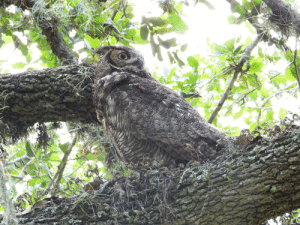One night, several years ago, I heard what sounded like a horse neighing. Being in the suburbs at the time, I knew it wasn’t a horse, but actually the sound of an Eastern Screech-Owl. I rushed outside to find it, grabbing my spot light as I went, and started to shine to light around the tree branches. Screech-Owls are quite small, so I knew it might take a moment to get the light on it. When I finally found it, I was amazed at how well it blended in to the tree bark behind it. If I hadn’t known it was there, I would never have spotted it.
Many animals have the amazing ability to match their appearance to their environment. Camouflage in the natural world is also called cryptic coloration. This ability acts like a defense mechanism for animals that allows them to disguise their appearance, masking their location, identity, and movement. This provides an advantage for the individual, concealing them from possible predators and sometimes prey.
Camouflage itself is created differently depending on the species. Some animals use feather or fur coloration to match their environment, but these have very different properties. Feathers or scales can be replaced fairly quickly and regularly, but fur can take weeks or months to grow. Animals with fur are more likely to be camouflaged by season; for example, the arctic fox is brown during the summer months and white during the winter.
Another consideration for camouflage and how it is created is if the animal is a social or solitary animal. The black and white stripes on a zebra make it stand out, but because zebras congregate in large herds, it can be impossible for a predator to pick out an individual animal.
Easily the most common example of background matching is the chameleon. Many people think the chameleon is able to change their skin color and pattern to match whatever their background is, but that actually isn’t true. Chameleons have a group of patterns and colors that they can display by changing hormone levels and nerve impulses in their skin, creating the blended colors that we see.
Other reptiles, and some insects, use camouflage as a warning. Warning colorations signal to potential predators that the animal is toxic or dangerous. An example from our area is the coral snake. With brightly colored rings, the coral snake is alerting other species to its toxic venom. Interestingly, the coloration pattern is so well known that there are other species, like the scarlet king snake, that attempt to mimic the colors and patterns.
For birds, camouflage can be vital to their survival. Raptors blend in to surprise their prey, while birds that don’t want to become prey want to be less conspicuous. Camouflage can also be important for nesting birds, who are vulnerable while siting on their nests. Many ground nesting birds have feathers that match the colors of the ground where they live, whether it be forest, beach, or marsh. American Bitterns have stripes lining their necks; when they extend their heads up all the way, they look just like the marsh grass around them.
As birders, we often emphasize the value of learning bird calls and songs, and this is a prime example for why that is so important. We are often out birding and we stop when we hear a bird call; we always hope to see it, but often we can’t find it because of how well the bird blends in to its environment. Next time you’re out, take a moment to appreciate the colors of the animals you see, and think about how those colors provide protection for the animal. Animals are amazing, and we can learn a lot from them!

